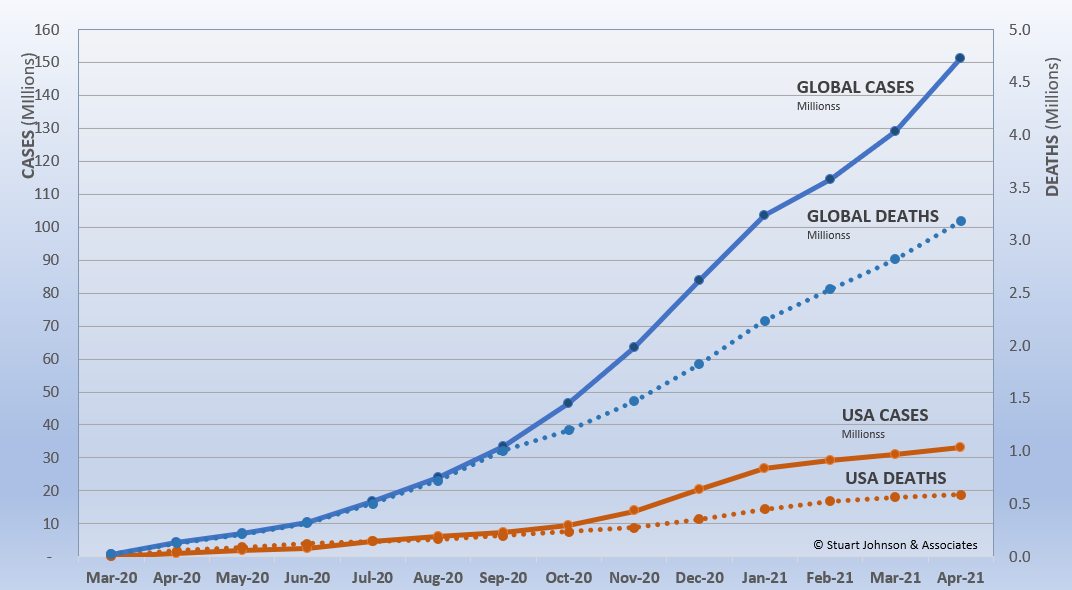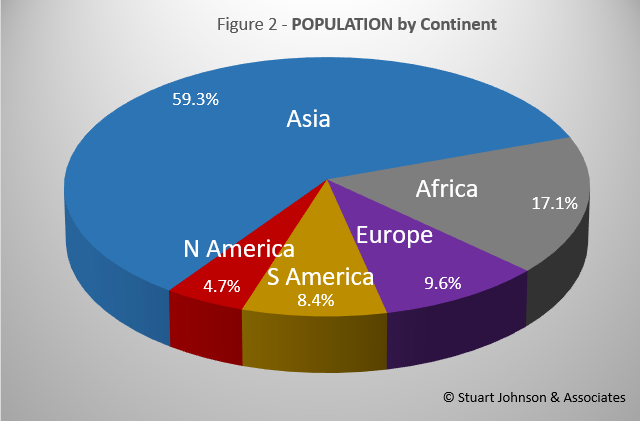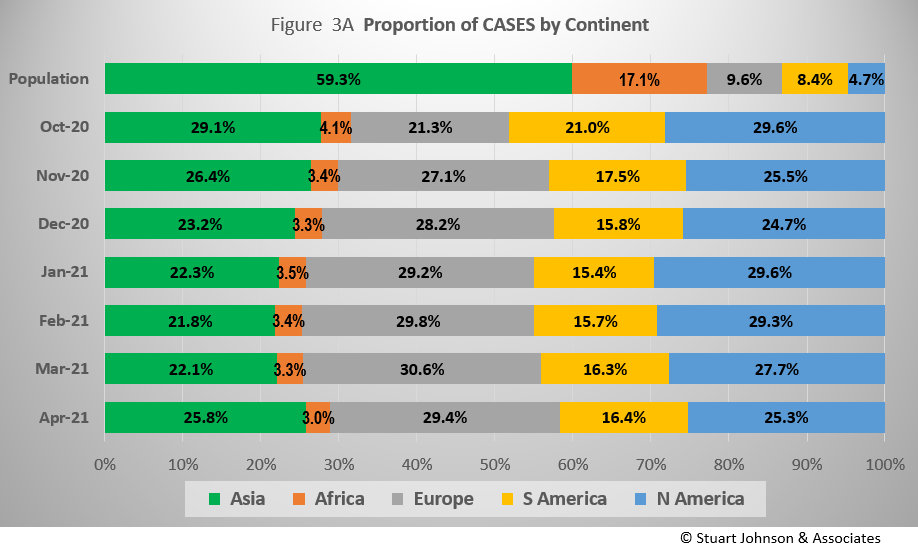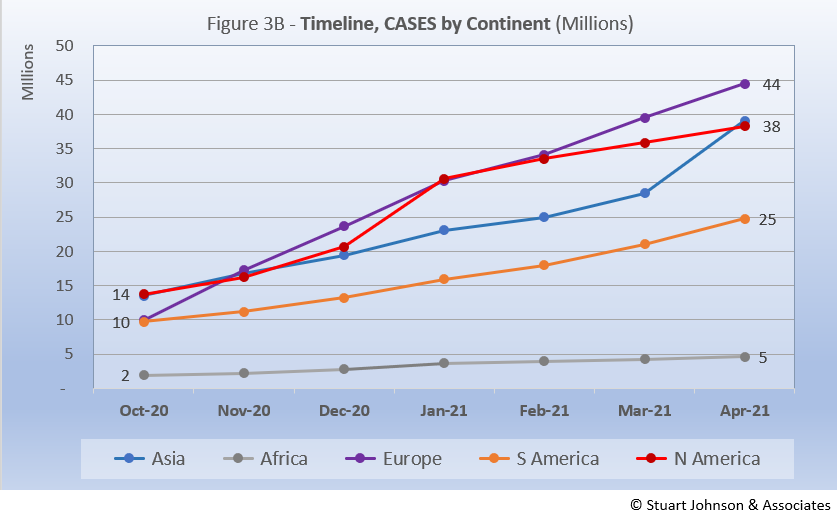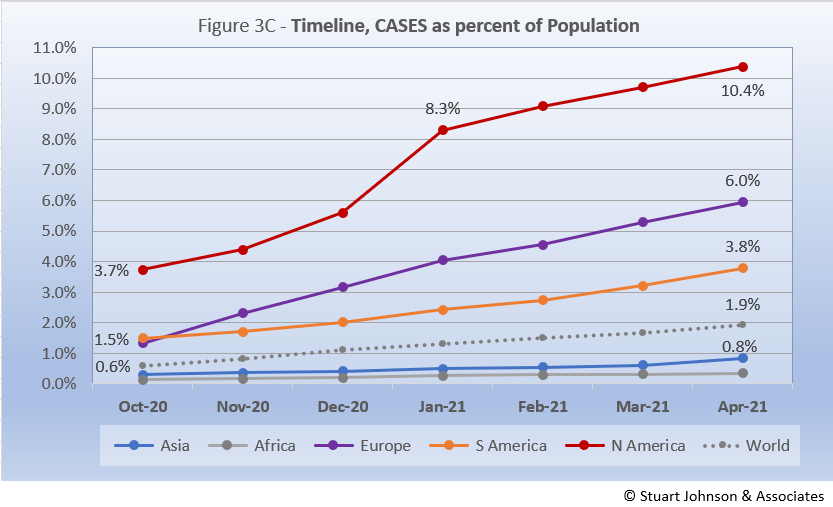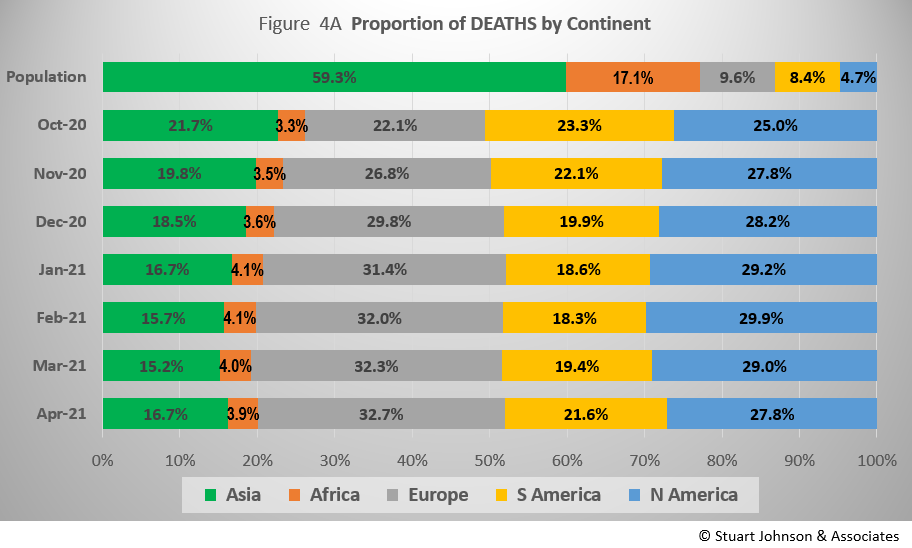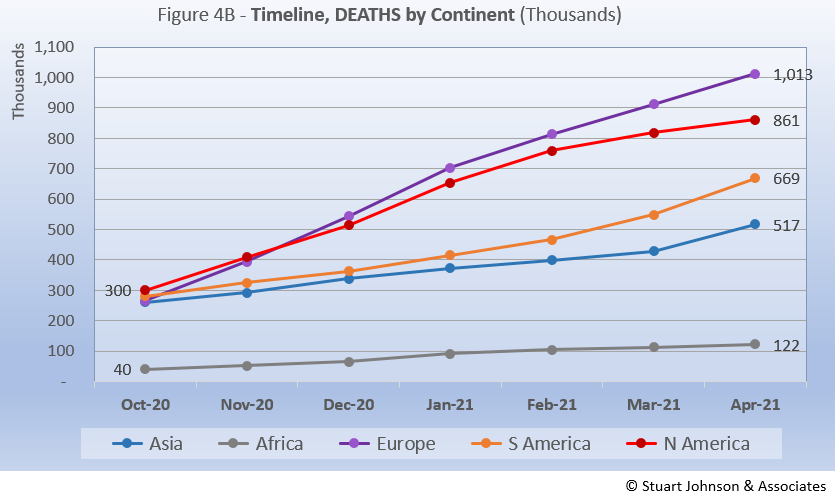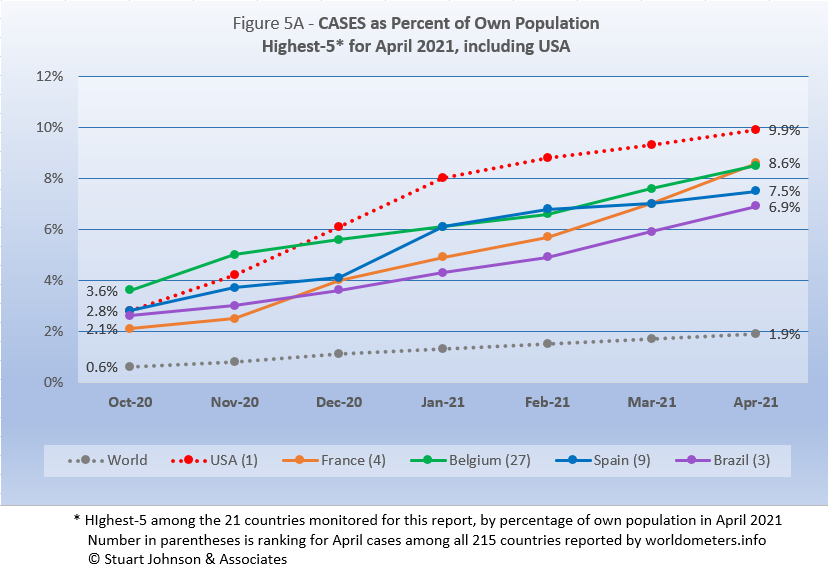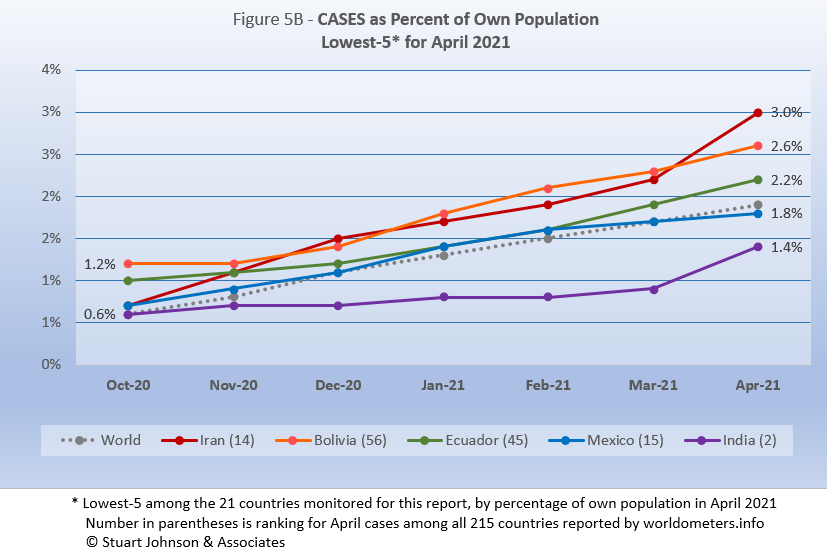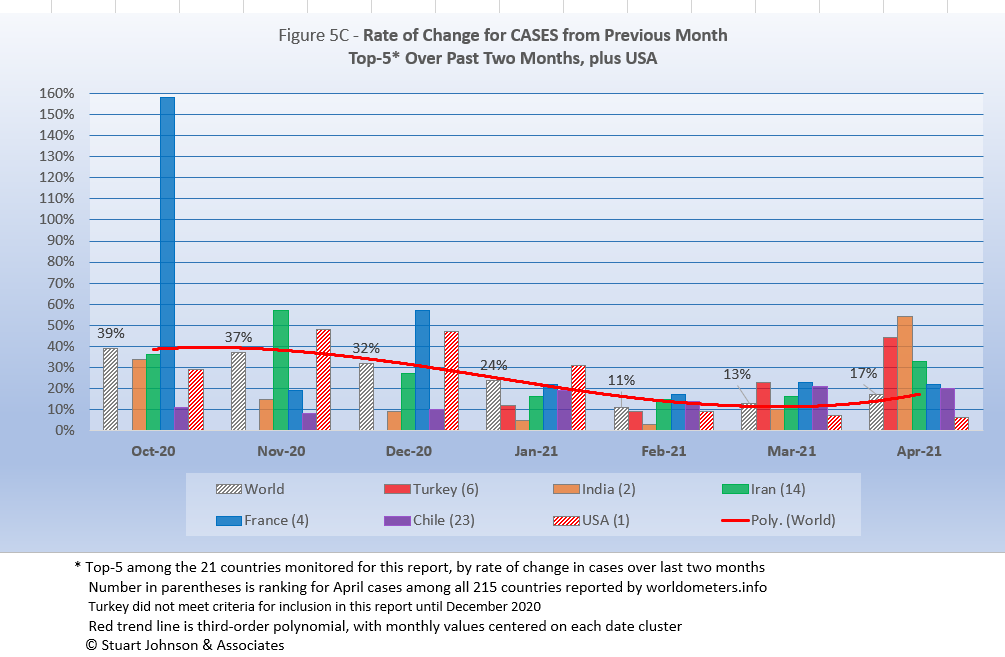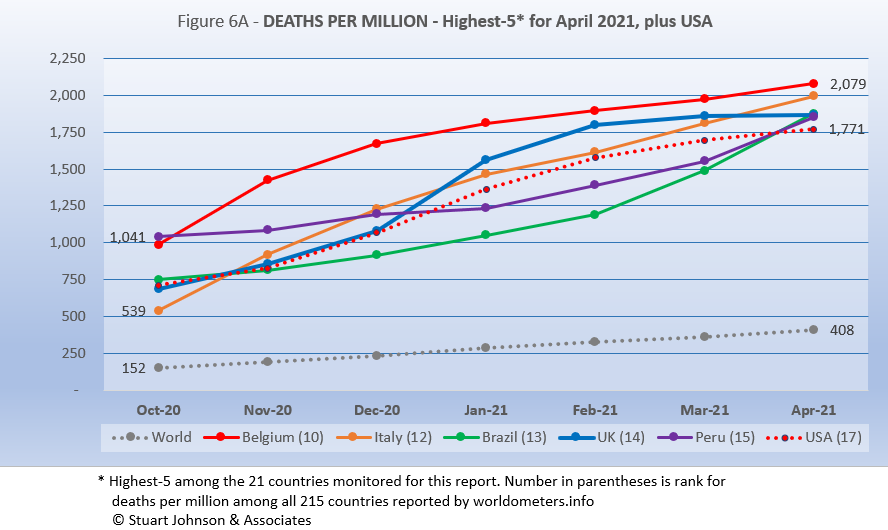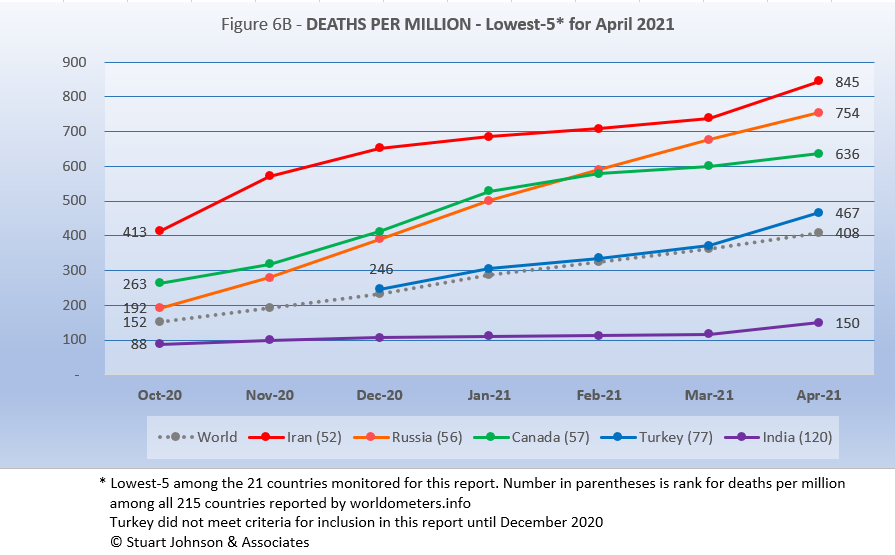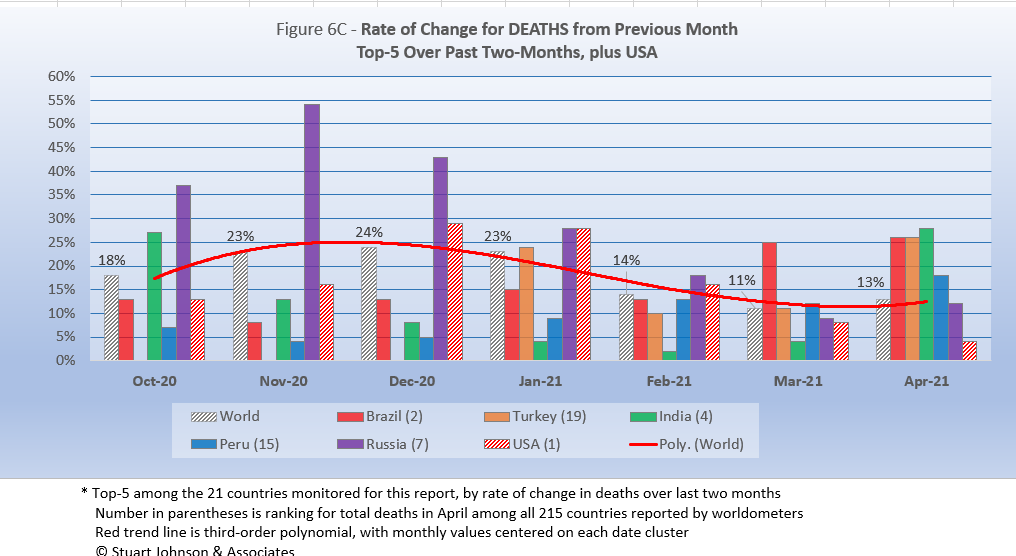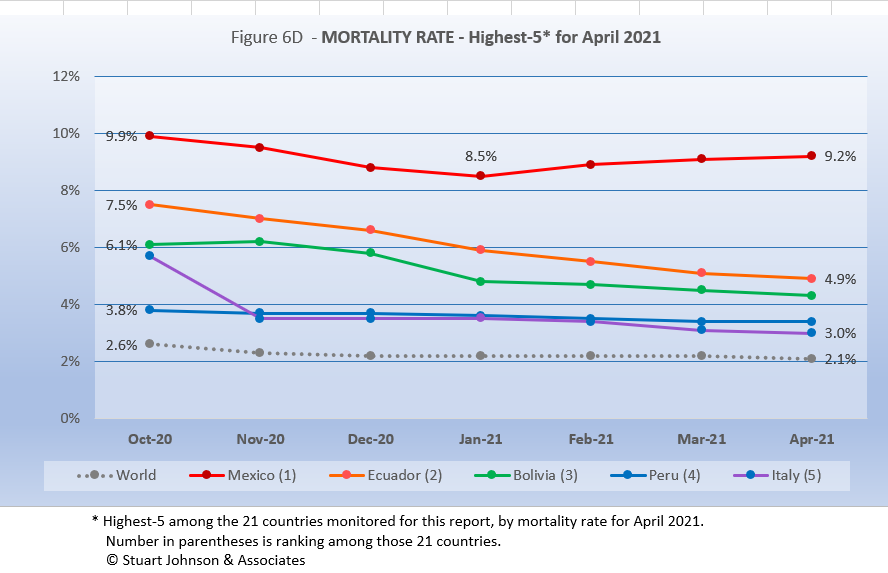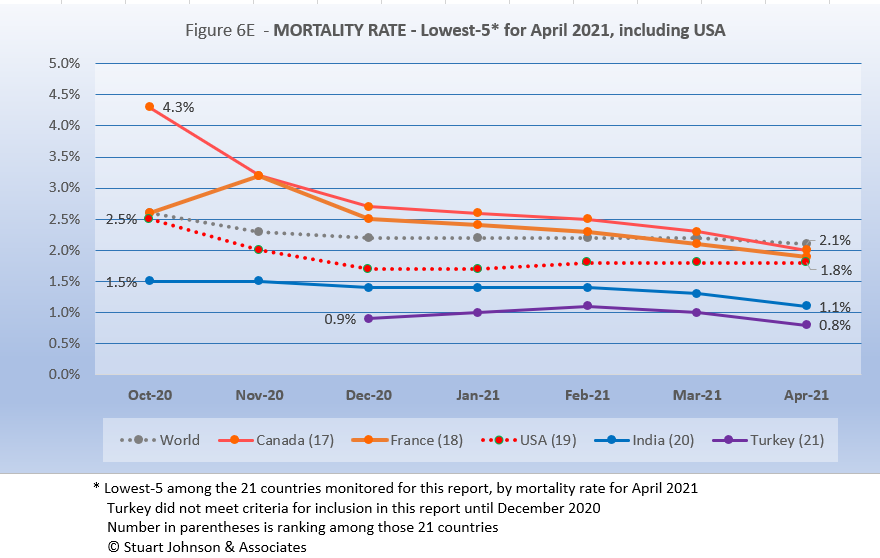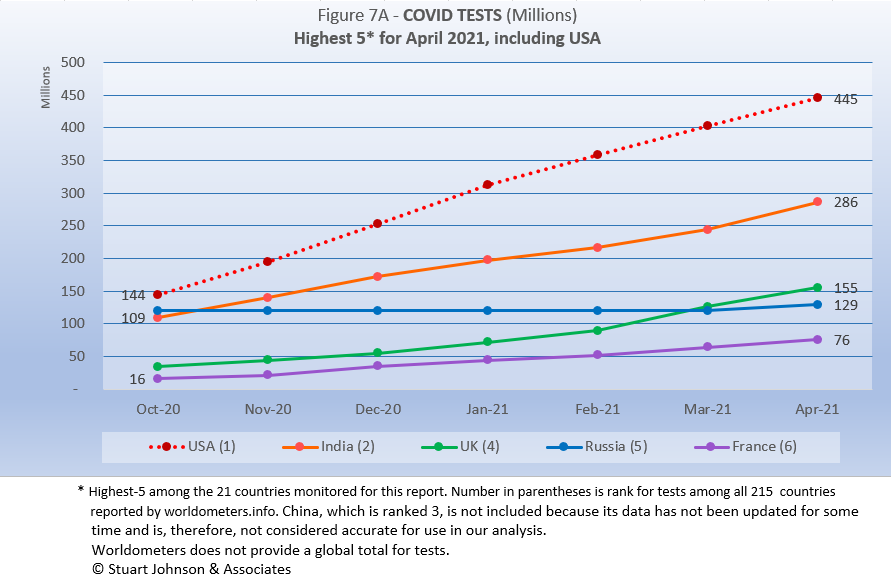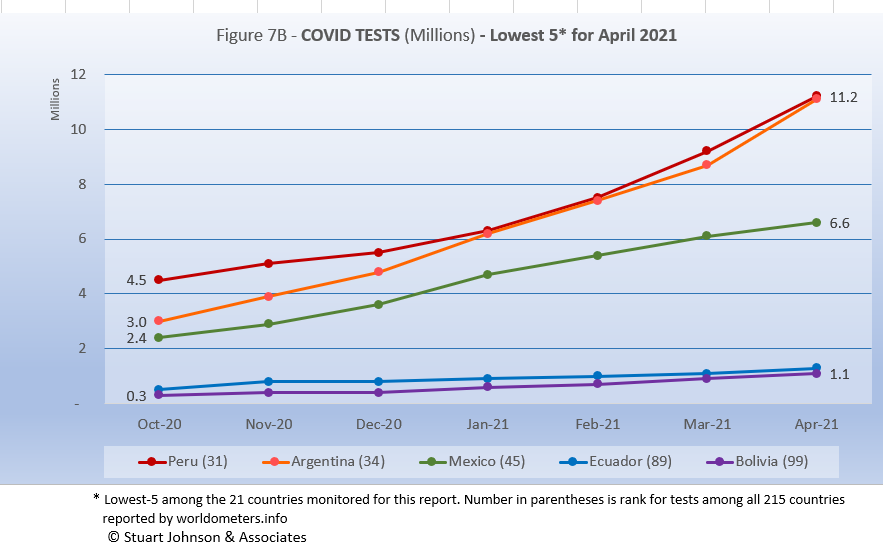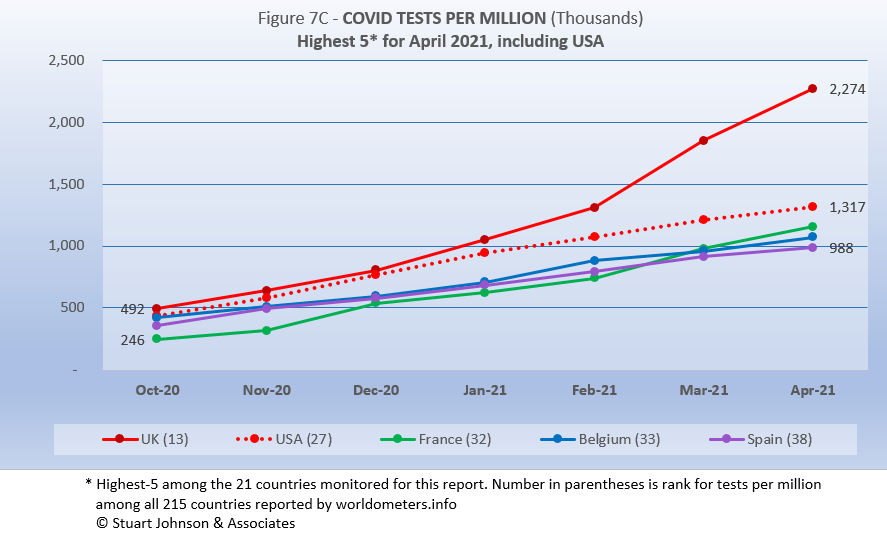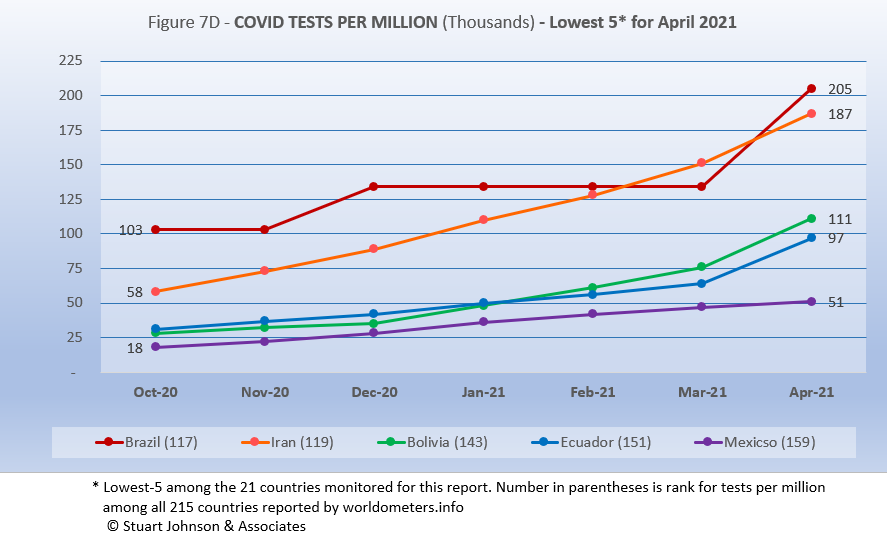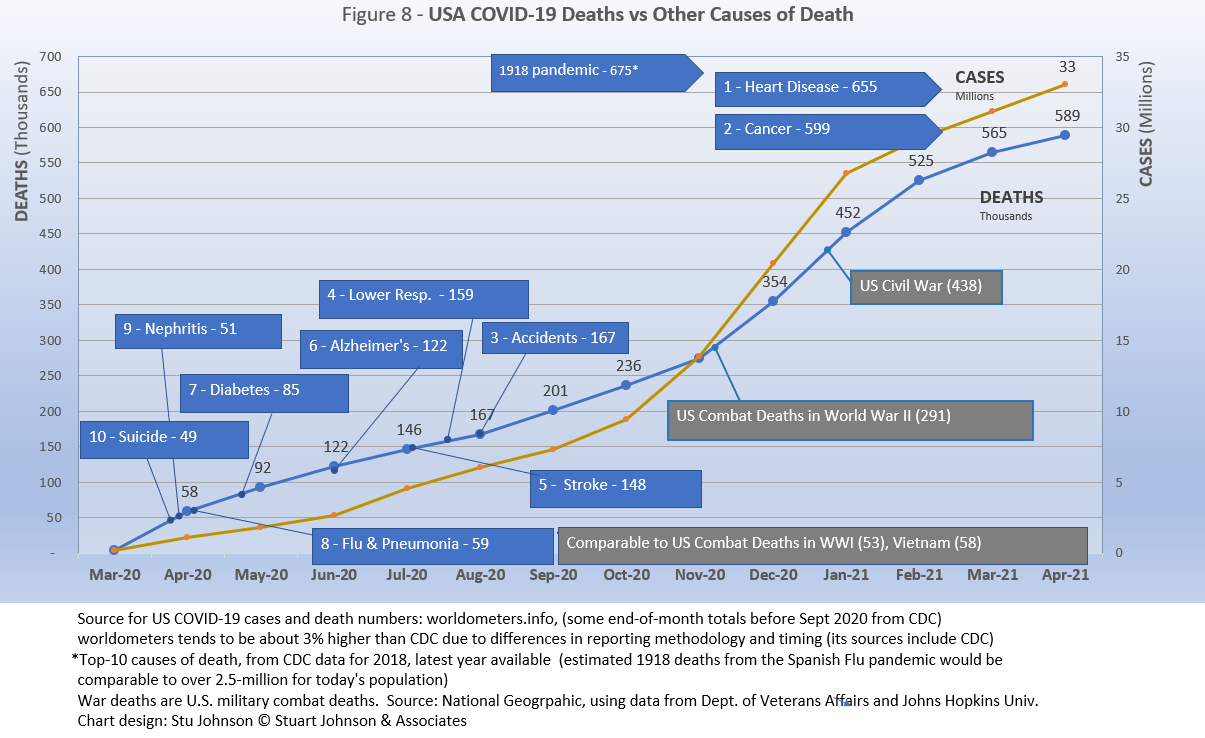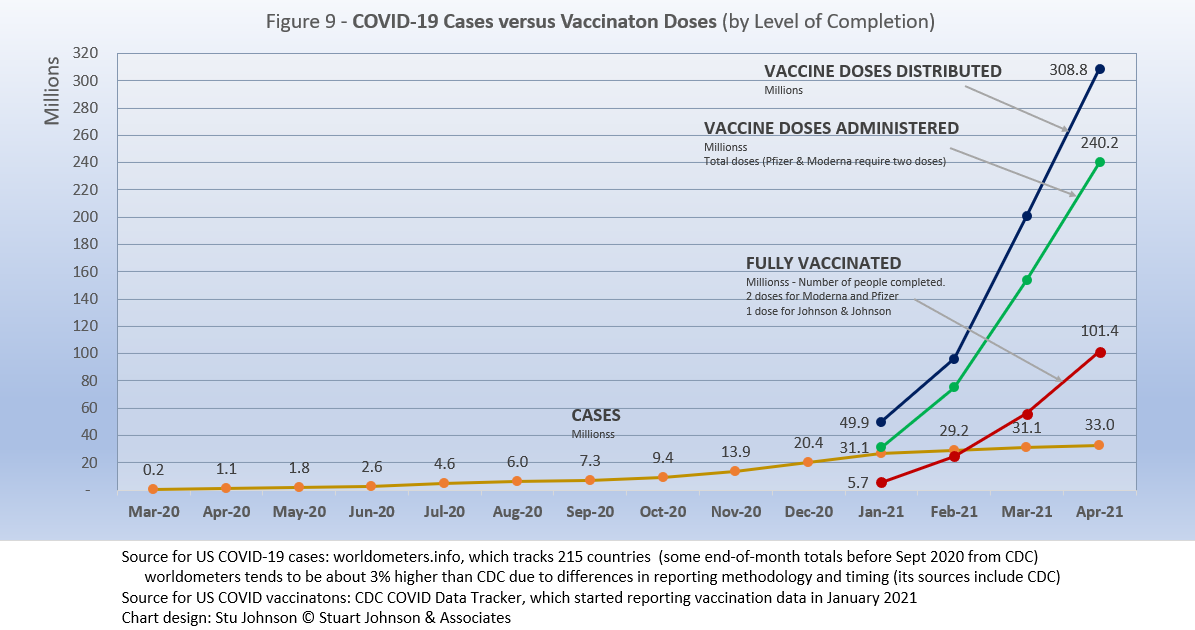





See listing of Recent and Most Popular articles on the Home Page
Health & Wellness
Category: News & Current Events / Topics: COVID-19 • Crisis • Dying and Death • Disease • History • News • Statistics
COVID-19 Perspectives for April 2021
by Stu Johnson
Posted: May 4, 2021
Bending the curve: US going in right direction, India and others now in crisis…
Putting the COVID-19 pandemic numbers in perspective (Number 10)
See a list of all of my articles related to COVID-19
This series was spawned by my reaction to reporting on the COVID-19 pandemic that focused on raw numbers. Big numbers are impressive, even frightening, and hard to comprehend. Rarely have we been given a context that helps lead to better understanding of the numbers or how to make comparisons between the U.S. and the rest of the world. This series has turned from occasional pieces to a monthly summary setting the U.S. numbers in global perspective. This analysis is based on data from worldometers.info, which monitors 215 countries. From those, I focus on details for 21 countries that have appeared in the top-10 of worldometers metrics since I started more detailed tracking in September 2020.
A note on reliability of data: It should be noted that the statistics reported by worldometers and other sources is only as good as the integrity of the reporting system in each country. China's statistics have increased so little since October that it is doubtful its numbers are accurate, so they are not included in some of the charts. Other countries have also had gaps in reporting, or made adjustments when admissions of underreporting have been made. While precise comparisons between countries may be brought into question, there is still enough information to make trends evident. That is why I may tend to round some numbers and watch for changes over two or three months rather than focusing on a single month, as significant as that may turn out to be.
New in this report: you can click on chart to enlarge it. A new tab or window will open to display the larger image. Close it to return to the report.
Report Sections:
• April at-a-glance
• The Continental View • USA Compared to Top-5 Countries
• COVID Deaths Compared to the Leading Causes of Death in the U.S.
• U.S. COVID Cases versus Vaccinations
• Profile of Monitored Continents & Countries • Scope of This Report
April-at-a-glance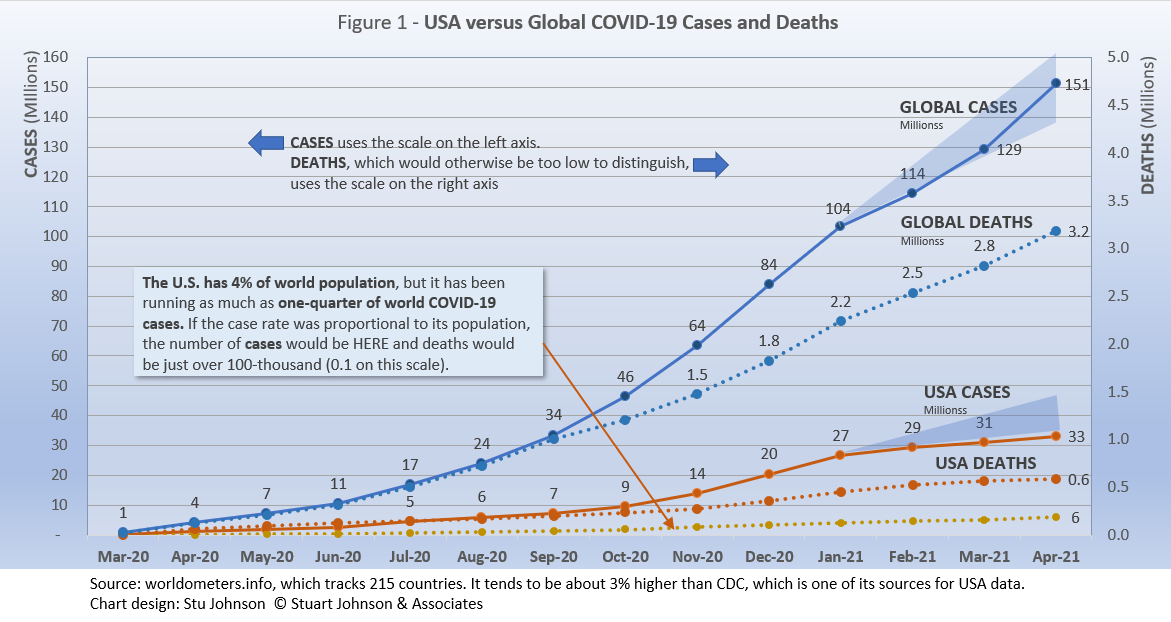
- COVID-19 continued to spread around the world, reaching 151-million cases by the end of April. After a rapid increase from September through January, February appeared to "bend the curve" downward, with only a slight upward move in March. April, sadly, brought record surges with India especially hard hit, hearkening back to the situation a year ago in Italy where it overwhelmed the health care system at the beginning of what was identified as a global pandemic.
- The pattern for deaths tends to lag behind cases by several weeks, and it is slowing—dropping from a 23% increase in January to 11% in March, it then turned back up slightly with a 13% increase in April. Because of the lag in deaths, we are likely to see that number climb in May because of major surges in some countries, even as others are experiencing a downturn in deaths. Ironically, while many countries can claim to see light at the end of the tunnel, others are cast into deeper despair and uncertainty.
- The U.S. continues to lead the world in the number of reported cases and deaths, maintaining the unfavorable distinction of having 22%r of world cases with only 4% of world population. (It rose from 20.3% in October to a high of 25.9% in January, then moved down again, ending March at 24.1% before dropping even more in April, to 21.8%). The U.S. share of deaths has been closer to 20% for months, but moved downward to 18.5% at the end of April—better but still exceedingly disproportionate.
Figure 1 shows how much lower cases would be—at about 6-million by now, instead of 33-million—if they were proportional to the global population, with just over 100-thousand deaths instead of nearly 600-thousand. One must be careful, however, in stating the situation so simplistically, as the reality is a complex set of factors. Yet, it cannot be denied that the U.S. share has been extraordinarily high compared to other large countries. - While global cases increased significantly in April, the downturn in U.S. cases that was first evidenced in February continued into April. The contrast is evident in the shaded cones added to Figure 1 this month for global and U.S. cases. Similar to the prediction of where a hurricane will make landfall, the upper edge of the cone represents a continuation of the steepest upward bend, from November through January. The bottom edge of the cone represents a continuation of the downturn in February.
As you can see in Figure 1, had global cases continued at the November-January pace, we would now be at around 160-million cases. On the other hand, had the February dip continued, we would be just under 140-million cases. The curve bent downward for two months, then returned to the center of the projected extremes in April. For the U.S. the picture is more promising, with the actual trajectory of cases bending below the projection for three months, ending April with 33-million cases, where the November-January pace would have placed it at about 45-million. - With vaccinations, the U.S. continues to move ahead with remarkable speed. Compared to the cases and deaths curves, the trajectory of vaccinations remains rocket-like (see Figure 9). From initiation in January, vaccinations at the end of April had fully covered 101-million individuals (nearly one-third of the entire population)—double the level at the end of March. There has been a total of 308-million doses distributed and 240-million doses "in the arms" of adults. Pfizer and Moderna require two doses, Johnson & Johnson (the latest to join the effort) requires a single dose. The AstraZeneca version, which had been halted in Europe because of reports of rare blood clots and has not yet been approved for use in the U.S., but was being offered to India in the face of its surging infection and death.
The Continental View
While COVID-19 has been classified as a global pandemic, it is not distributed evenly around the world, though events in April may begin to change that.
Asia accounts for nearly 60% of the world's population (Figure 2), but only 26% of COVID cases—affecting only 0.8% of its population—in April (Figure 3A). In fact, where Asia and Africa combined represent about three-quarters (76.4%) of the world's 7.8-billion people, Europe, South America and North America still account for more than 7 in 10 cases (71.1%, Figure 3A) and 79.9% of deaths (Figure 4A).
By the numbers alone, Europe remains in the lead with 44-million cases at the end of April—an increase of 13% compared to the global increase of 17% from March. The real story in April is the significant advance of cases in Asia, moving it into second place with 39-million (up 10-million or 37%), slightly ahead of North America, with 38-million. North America, which shot up 48% in January to match Europe, has been slowing in growth of cases since then. South America has seen steady increase of cases since October, with a very slight upward bend in April, bringing its total to 25-millions cases (an 18% increase).
Remembering proportionality, however, North America should not be equal to Europe in impact. Figure 3C, which translates raw case numbers to percentage of population, makes this clear. After a sharp increase in January, North America slowed its growth, but still ended April with just over one-tenth of its population with reported COVID cases. The other continents have been growing at a steadier pace. Because of its huge population, the significant increases in cases in Asia, produces a noticeable but comparatively small upward bend in the curve for April. In total, Asia and Africa, the most populous continents, remain below the global level of 1.9% of population with reported COVID cases.
The proportion of deaths between continents is even more distorted than that of cases. Figure 4A shows the steady increase in the proportion of deaths in Europe and the Americas. April ended with Asia and Africa (76.4% of world population) accounting for 20% of COVID deaths, up one percent since March. Even though India was in crisis, an even more serious impact on death statistics will be more evident in the May numbers.
Europe has increased 48% since October, while North America increased 16% from October to March, then dropped 13% since then, actually ending April 7% lower than October. South America went down in proportion 21% from October to February, then increased 18% in March and April, up 11% from October.
The percentages used here may seem off if you're just comparing the numbers on the chart, but it is calculated by dividing the difference between two months. For example, Europe was at 22.1% in October, 32.7% in April. Therefore: 10.6 (difference between October and April) divided by 22.1 (starting point) = 47.96% difference, rounded to 48%..
The overall distribution for deaths through April shows how that trajectory lags behind cases and has progressed at a steadier rate. Back in October, Asia, Europe and the Americas were close together in raw numbers. Europe and North America began a steady upward climb, with Europe surpassing North America by December, taking a very slight downturn in February, continuing at that pace to end April with just over 1-million deaths. North America has tracked below Europe since December, taking a similar downturn in February and another in March and April, ending with 861-thousand deaths and a widening gap with Europe (by raw numbers).
On the other hand, South America started at a slower pace of growth in deaths, but started to bend upward in March and even more in April, ending with 669-thousand deaths. Meanwhile, Asia progressed steadily, below South America but following its upward turn to end April at 517-thousand deaths. Africa has remained the lowest and slowest in growth, ending April with 122-thousand deaths.
Thus, by numbers alone, we can say that Africa continues at a very slow and steady pace, North America is slowing down, Europe remains on a steady path that could move either way, while Asia and South America have emerged as current continental hot spots.
Comparison of U.S. to Top-5 Countries
Cases
Brazil replaces UK in fifth place in April. UK dropped to eighth place in April, behind Italy and Argentina.
Early on, the small European country of Belgium was leading the world in COVID cases as a proportion of its population (Figure 5A). The U.S. and Spain were nearly a full percentage point lower in October. Belgium began to level off in December, while the U.S. continued climbing, with a slight acceleration in December that continued into January, then began to slow. Even so, the U.S. ended April with 9.9% of its population with reported COVID cases, far above the 1.9% global level and one to three percentage points higher than the next four countries. (That, however, is a smaller gap than March, when the next four were two to four points behind).
France started as the lowest of the April top-5 back in October, bumped up in December and again in March and April at 8.6% of its population with reported cases, nudging past Belgium, which began first among the five in October then slowed in growth after November to end slightly behind France at 8.5%. Spain has been more erratic, with a sharp rise in January, then slowing considerably, ending April at 7.5%. Brazil has risen steadily and well ahead of the global pace, ending April at 6.9%.
Another way to look at population proportion is the measure "1 in." The global figure of 1.9% means that 1 in 52 people in the world have had COVID (and that only by official record keeping, not including any unreported and likely asymptomatic cases). For the U.S., at 9.9% that means 1 in
10. For Brazil it is 1 in 15.
The same five countries appear in the lowest-5 (of the 21 I track), with Iran trading places with Bolivia for the "highest of the low."
At the low end (Fig. 5B), the five lowest countries for cases by proportion of population are much closer to the global figure of 1.9% of population with confirmed cases of COVID-19 at the end of April. While attention has been focused on India, which jumped from 0.9% in March to 1.4% in April (but remains the lowest of the 21 countries I track, and below the global total of 1.9%), Iran saw a slightly larger percentage move, from 2.2% in March to 3.0% in April, moving it from a tie for third lowest in October to fifth highest in April.
Those countries represent a considerable spread in size, from India, the second largest country, to Bolivia, ranked number 50 of the 215 countries tracked by worldometers. For Iran, its 3.0% level represents 1 in 34 people, for India it is 1 in 74 (up from 1 in 113 last month). .
Because the size of countries makes the use of raw case numbers illusory, another measure I find helpful is the rate of change from month to month (Figure 5C).
For this chart, countries are selected based on the change over two-months (end of February to end of April for this report). Except for the U.S. (which will appear every month), the mix has changed since the last report, with Turkey, India, and Iran replacing Italy, Brazil, and Peru.
The latter dropped to 10, 8, and 11 respectively for the current two-month change.
The overall trend (red line) was moving down through February, then went up 2% in March and another 4% in April. One observation seems to bear some weight: as the global level of change goes down, variance between countries in the top-5 also flattens out. In February, two of the top-five were below the global change that month. In March, with the trend starting to go up, only one of the five was below the global level, and in April all of the top-5 were above the global level, with more difference between them than in the previous three months. This is an indication that the global level can be pulled upward by a few countries, even as others continue slowing or going down. The U.S. for example, a key factor in global statistics, was above global levels of change from November through January, then has been at or below the global level through April.
Turkey has the highest two-month change for April, at 78%, with a 23% increase in March followed by another 44% increase in April. (Because of the math, the two-month figure is not the same as adding the individual changes from month to month). India, on the other hand, was below the global rate in March (10% versus 13%, but then experienced a 54% increase in April, with a two-month figure of 69%, second place behind Turkey.
The paradox of India. Because of the vast size of India (nearly 1.4-billion people), even staggering numbers that exceed the entire population of many of the 215 countries tracked by worldometers hardly make a dent in many of the charts in this report. For example, as this report is being written, there are news stories of a single day increase of 400-thousand cases in India. In the last two weeks of April, cases increased by 5-million—roughly half of the 10.4-million new cases reported globally in that time. Yet, as a percentage of population, India remains in the lowest five of the 21 countries I track. What is notable, and worrisome, however, is the intensity of this surge and the question of how long it will persist and how far it will spread. Yet, while a huge number can be statistically insignificant, each death is a singular human tragedy of immense significance to the families and communities affected.
Deaths
Because deaths as a percentage of population is such a small number, the "deaths per million" metric provides a comparable measure.
Spain and USA drop out of the top-5 for April, replaced by Brazil and Peru. (USA remains in the chart, however).
As Figure 6A shows, Belgium continues to lead the world, though its rate has been slowing as other countries continue to rise. The remaining top-5 began to separate more through February as UK surged and others continued above the global rate of change. Then, UK slowed, ending April in a virtual tie with Brazil and Peru, which both moved into the top-5 because their rates were bending upward. The U.S. began to slow, not as significantly as UK, but enough to drop out of the top-5 (at No. 6).
The overall trend shown in Figure 6A is that the UK and USA, with aggressive testing and vaccination, are beginning to slow the death rate, while Europe (represented by Belgium and Italy) continue to climb, showing the frustration over slow vaccination roll-outs, including delays because of suspension of the AstraZeneca vaccine over concerns about extremely rare but serious blood clotting.
At the same time, the entry of Brazil and Peru into the top-5 follows the movement of COVID hot spots to South America and Asia (though because of sheer size, Asia remains at the low end of Deaths per Million, even though showing significant increases in the next chart).
The same five countries, in the same order, continue in the lowest-5 in Deaths per Million (of the 21 countries tracked for this report).
India remained well below the global rate of 408 deaths per million at the end of April, but like Turkey and Iran, it showed a noticeable increase since March. With Russia at a steady pace, with no sign of easing, Iran had been on a trajectory that could have moved it below Russia in another month. Now, it actually widened the gap with Russia ever so slightly. Even Canada, which has been slowing in rate of growth since January, shows a slight upward bend in April.
As with the comparable chart for Rate of Change for Cases (Figure 5C), countries are selected based on the change over two-months (end of February to end of April for this report). Except for the U.S. (which will appear every month), the mix has changed since the last report, with Turkey, India, and Peru replacing Germany, Spain, and Mexico. The latter have fallen to 12, 15 and 14 respectively in two-month change.
The trend in the rate of change in deaths (red line in Figure 6C) shows the delayed connection with cases. Monthly changes for cases were trending down from October through February then started moving up again in March and April. For deaths the trend peaked in December before starting to go down. hitting a low of 11% in March, then moving up to 13% in April.
Brazil had been below the global rate of change until March, where it increased 25%, followed by a 26% increase in deaths in April (a 58% increase over the end of February). Turkey, which did not meet criteria for this report until January, started above the global rate, then dipped below it for two months, before climbing 26% in April (39% since the end of February). India increased the most in April, at 28%, but it was well below the global level of change for five months, making its two-month change 33% (back in October, India experienced a similar single month change, at 27%).
USA dropped out of the top-5, having peaked in December and January, before dropping to 16% in February when the global rate was 14%, then fell below the global rate of 11% by ending March with an 8% increase over February.
Mortality Rates (percentage of deaths against reported cases) have been slowly declining. This is not surprising as several factors came into play: the ratio of community spread versus outbreaks (nursing homes, similar confined settings) increased, lessons being applied to treatment, increased testing (which would expand the spread between reported cases and deaths), and increasing vaccinations since January (though that should impact both cases and deaths).
The top-5 in mortality rate (among the 21 countries observed) stand out because for the most part they had not been showing up in other charts until the past month or two. Iran appeared last month, but was replaced by Italy this month. The others remain in the same order, All remain above the global mortality rate, which was 2.1% at the end of April.
Mexico, which has had the worst mortality rate, was trending down into January, then starting to move upward again, though the pace slowed in April, moving up only one-tenth of a percent, to 9.2%. The others have all moved down since October, getting closer to each other and to the global level—and increasing the gap between them and Mexico. Peru has been nearly level, dropping from 3.8% in October to 3.4% in April. Italy, after devastating months at the beginning of COVID, settled into a slowly declining mortality rate which has improved even more obviously in the last two months, ending April at 3.0%.
France moved into the lowest-5 in March, replacing Spain. This month, Canada replaces Russia, which moved up to 13 of the 21 countries monitored for this report.
Canada has declined steadily from 4.3% in October to 2.0% in April, putting all five of the lowest mortality rates below the global level of 2.1%.
France went up in November, then followed Canada, ending at 1.9% in April. USA started and ended very close to the French level, but their trajectories widened in the intervening months before coming back together in April. India's rate has begun to accelerate since February as cases surge and deaths lag behind. We'll have to see how badly the death rate increases in May and whether than will pull the mortality rate higher.
How real is the threat of death from COVID? That's where successful mitigation comes in. Worldwide, by April, 1 in 2,458 people have died from COVID. In the U.S., while the mortality rate is low, because the number of cases is so high, 1 in 566 have died through April (down from 924 in December). With low mortality, the U.S. should have been able to keep deaths much lower, but the extraordinarily high number of cases means more deaths. Without a better-than-global mortality rate, the U.S. death rate would be far higher. And compared to the 1918 pandemic, it could be ten times worse. The response of the health care system is part of keeping mortality down, but it's far too early to detail the cause for that positive piece of the COVID picture in the U.S. Even at the global level of 2.1%, the U.S. would have had 693-thousand deaths by the end of April, instead of 589-thousand.
Tests
The same five countries remain on top in COVID testings, in the same order as March.
The U.S. is far ahead of other countries in reported COVID tests administered, at 445 million, 56% ahead of India (narrowed from 65% the last two months). These are raw numbers, though, so it is important to recognize the size of the country. It is also the case that COVID tests can be administered multiple times to the same person, so it cannot be assumed that the U.S. has tested almost all of its population of some 330-million. Some schools and organizations with in-person gatherings are testing as frequently as once a week for those who are not yet fully vaccinated. That's a lot of testing!
The same five countries, in the same order, remain the lowest in COVID testing.
There is tremendous disparity between countries in terms of testing. The five countries (among the 21 monitored) with the lowest reported number of tests are all in South America. Peru and Argentina are good examples, both having achieved over 11-million tests through April. Argentina (11.1-million tests for its 45-million population) is well below Spain (46.2-million tests and a population of 47-million). Similarly, Peru (11.2-million tests and 33-million people) is also well below Canada (31.3-million tests and 38-million people). At the bottom, Ecuador has reported 1.1-milion tests for its nearly 18-million people and Bolivia has tested 899-thouand for its 12-million population.
Tests per million adds another perspective. Fig. 7C shows the five countries with the highest tests per million. France replaced Russia last month, but this month's top-5 consists of the same countries in the same order.
The UK, already the most aggressive in testing, increased its numeric lead even more in April, with a reported 2.27-million tests per million population, the equivalent of more than 2 tests per person. The U.S. continues on a straight line trajectory, reaching 1,32-million tests per million, just over one per person. France, Belgium and Spain track close to each other, all ending close to 1-million tests per million in April. France was number 5 from October through February, then moved ahead of Belgium and Span by a small margin to end in 3rd place in April. .
Anything over 1,000 represents more tests than people (1,000 on the chart actually means 1,000,000), but as mentioned above, that does not mean that everyone had been tested. Some people have been tested more than once, and some are being test regularly or with increased frequency.
The same five countries appear as the lowest five in tests per million in April, with Iran and Brazil trading rankings as Brazil apparently caught up in its statistics after three months with no changes. Brazil has doubled tests since October, while Iran steadily increased to three times its position in October. While Bolivia and Ecuador appeared at the bottom in the number of tests, the small gains each has made are amplified when translated to tests per million. Mexico, on the other hand, which appeared to make more progress in tests given remains more even when looking at tests per million. While incremental improvement is evident in four of the five, the equivalent proportion of tests to population remains very low, from roughly 5% to 20%. This illustrates the arguments over inequity in resources among countries.
Causes of Death in U.S.
Early in the reporting on COVID, as the death rate climbed in the U.S., a great deal of attention was given to benchmarks, most notably as it approached 58,000, matching the number of American military deaths in the Vietnam War. At that time, I wrote the first article in this series, "About Those Numbers," in which I looked at ways of viewing the data, which at the time of that writing in May 2020 was still focused on worst-case models and familiar benchmarks, like Vietnam. Part of my approach in that article was to put the U.S. COVID deaths on a timeline against not only mileposts like war deaths or significant numbers (i.e., every 50,000 or 100,000), but against the reality of the top-10 causes of death each year, numbers available from the CDC.
Most media sources reported that the U.S. would pass 500,000 deaths on February 22, 2021. The CDC reported 497,415 deaths on February 21, while worldometer.info was already reporting 512,068. As mentioned elsewhere in this report, worldometer tends to be about 3% ahead of CDC and Johns Hopkins, a matter of a few days difference in data collection. At any rate, it is clear that February saw the U.S. death toll from COVID passed the 500,000 mark, headed toward 600,000. The pace in March and April slowed somewhat, with the total of 589-thousand still short of the next significant milepost of 599-thousand, the number who died from Cancer in 2018, the latest full year reported by the CDC.
Figure 8 shows the number of U.S. COVID cases and deaths against the top-10 causes of death reported by CDC for 2018, along with several other mileposts from wars and the 1918 pandemic. Notice that for nearly nine months, the curve for deaths was increasing at a faster rate than cases. Then, starting in November the curve for cases took a decided turn upward, while deaths increased at a more moderate pace.
The February slowdown in cases was met by a barely perceptible slowdown in deaths, because as pointed out earlier, deaths trail changes in cases. That trend continued in March and bent downward even more in April. In fact, if the trajectory from November to February had continued, we would have seen close to 750-thousands by the end of April. Instead, the curve slowed enough to avoid that milepost for now, but extremely close to it.
The latest "Ensemble Forecast" from CDC suggests this for the immediate future:
...the number of newly reported COVID-19 deaths will remain stable or have an uncertain trend over the next 4 weeks, with 1,900 to 6,600 new deaths likely reported in the week ending May 22, 2021. The national ensemble predicts that a total of 583,000 to 595,000 COVID-19 deaths will be reported by this date.
Note: As I've referenced in the notes for several charts, the data from worldometers.info tends to be ahead of CDC and Johns Hopkins by about 3%, because of reporting methodology and timing. I use it as a primary source because its main table is very easy to sort and provides the relevant data for these reports.
Perspective
The 1918-19 Spanish Flu pandemic is estimated to have struck 500 million people, 26.3% of the world population of 1.9-billion at that time. By contrast, we're now at 1.5% of the global population. Deaths a century ago have been widely estimated at between 50- and 100-million worldwide, putting the global mortality rate somewhere between 10 and 20-percent. It has been estimated that 675,000 died in the U.S.
IF COVID-19 hit at the same rate as 1918, we would see about 2-billion cases worldwide by the time COVID-19 is over, with the global population now at 7.8-billion—four times what it was in 1918. There would be 200- to 400-million deaths. The U.S. is estimated to have had 27-million cases (one-quarter of the population of 108-million) and 675,000 deaths. Today, with a population of 330-millions (a three-fold increase from 1918) this would mean more than 80-million cases, and 2- to 4-million deaths.
However, at the present rate of confirmed cases and mortality while the total number of global cases could approach 500 million or more—comparable to 1918 in number, that would be one-quarter of 1918 when taking population growth into account . .. and assuming the pandemic persists as long as the Spanish Flu, which went on in three waves over a two year period. At the present rate of increase (15-million cases per month) it would take 24 months to reach 500-million.
Using the global mortality rate of 2.1% in April, total deaths with the above projection of cases, would be over 12-million worldwide, tragic but far below the number reported for 1918 (50-million) with an even wider gap (200 million) when taking population growth into account.
With vaccination in progress and expected to be completed in the U.S. by the end of summer, the end of COVID-19 could come sooner. Like 1918, however, there could be complicating factors such as the growing number of mutations that are more highly transmissible (but not necessarily more deadly). It seems unlikely that the number of cases worldwide will reach 500-mllion, unless current hot spots like India, other countries in Asia, and countries throughout South America. Another wild card is Africa, which could remain an outlier during this pandemic, or explode into a major hot spot. It is simply too early to make predictions on the duration and severity of the COVID-19 pandemic.
The contrast demonstrates the vast difference in scale between the Spanish Flu pandemic a century ago and COVID-19 at the present time. Key differences are the mitigation efforts, available treatment today (though still leaving the health care system overwhelmed in some areas), and the beginning of vaccine distribution. In addition, in 1918 much of the world was focused on a brutal war among nations (World War I) rather than waging a war against the pandemic, which ran its course and was undoubtedly made much worse by the war, with trans-national troop movements, the close quarters of trench warfare, and large public gatherings supporting or protesting the war.
Vaccinations in the U.S.
With remarkable speed (it usually takes years to develop vaccines), two COVID vaccines were granted emergency approval for use in the U.S. starting in January—the one by Pfizer requires super-cold storage, which limits its deployment. The other, by Moderna, requires cold storage similar to other vaccines. Both of these require two doses, which means that vaccine dosages available must be divided in two to determine the number of people covered. By my March report, Johnson & Johnson had been granted approval for a single-dose vaccine. The numbers in Figure 9 represent the status of all three vaccines as of April 30.
A person is considered "fully vaccinated" two weeks after the final (or only) vaccine dose; roughly six weeks for Pfizer and Moderna and four weeks for Johnson & Johnson.
Early on (still somewhat evident in March) there was much anxiety about vaccine availability and scheduling appointments. In most parts of the U.S. now there are few problems getting appointments and walk-in clinics can be found in many locations. Now, the biggest concern is convincing the dubious, the deniers, and the resisters to get vaccinated and help the country reach herd immunity (about 70% of the population fully vaccinated). Apparently, "opening" based on vaccination status is beginning to persuade some who have been reluctant, admittedly so they won't "miss out" on the activities they are waiting to engage in again.
Vaccinating over 300 million people in the United States (much less a majority of the billions around the world) is a daunting task. It is a huge logistical challenge, from manufacture to distribution to administration. Yet, it remains amazing that any of this is possible this soon after the identification of the virus just over a year ago.
There is a delicate balance between maintaining hope with the reality that this is a huge and complicated logistical operation that will take time, though that time is now measured in months instead of years. As the richer countries with access to more resources make progress, the global situation is raising issues of equity and fairness within and between countries.
Several people were waiting to be vaccinated when I got my first dose. One was very positive about getting her first dose, then asked if she would still have to wear her mask after the second dose. YES, came the emphatic response from the four other people waiting their turn. YES, even if vaccinated, we will have to continue mitigation efforts until the curve of new cases finally flattens and we can be assured that COVID no longer has a hold on us.
A good example of the changes we are going through is at a food pantry where my wife and I volunteer. When COVID hit, the operation changed radically, from a "shopping" model to distribution of pre-loaded carts. Having engaged in strict protocols on cleaning, masks, gloves, social distancing for much of the last year, we are now beginning to ease some of them. Even though most volunteers are fully vaccinated, we will continue to wear masks and only allow volunteers inside the building. (All registration and distribution was moved outdoors, even through a rather harsh Midwestern winter, but we continued to serve people twice a week, with the exception of a few holiday closings). That illustrates the belief that vaccination is not a point where mitigation is no longer needed. We have a responsibility to those who come to be served, as well as to the others who volunteer.
We can grasp the hope that the end is in sight, but let's not throw it away by being foolhardy!
In the tendency to turn everything into a binary right-wrong or agree-disagree with the science perspective, we ignore the need to recognize the nature of science and the fact that we are dealing with very complicated issues. So, in addition to recommending excellent sources like the Centers for Disease Control and Prevention (CDC), it is also wise to consider multiple qualified sources.
Maintaining Perspective
While there has been much focus placed in trusting "the science," it is important to recognize that science itself changes over time based on research and available data. In the highly volatile political atmosphere we find ourselves in (not just in the U.S., but around the world), there is a danger of trying to silence voices of experts whose views are out of sync with "the science" as reported by the majority of media outlets. In an earlier report, I mentioned the
Greater Barrington Declaration, currently signed by nearly 57-thousand medical & public health scientists and medical practitioners, which states "As infectious disease epidemiologists and public health scientists we have grave concerns about the damaging physical and mental health impacts of the prevailing COVID-19 policies, and recommend an approach we call Focused Protection."
For a personal perspective from a scholar and practitioner who espouses an approach similar to the Focused Protection of the Greater Harrington Declaration, see comments by Scott W. Atlas, Robert Wesson Senior Fellow at the Hoover Institution at Stanford University, in an article "Science, Politics, and COVID: Will Truth Prevail?"
Last month on SeniorLifestyle I posted an article by Mallory Pickett of The New Yorker, "Sweden's Pandemic Experiment," which provides a fair evaluation of the very loose protocols adopted by Sweden, essentially a variation of the "Focused Protection" approach. The "jury is still out" on this one, so judge for yourself whether Sweden hit the mark any better than area you live in.
How we evaluate the many approaches used to deal with COVID will determine how we prepare for and approach the next global event.
My purpose in mentioning these sources is not to take a political position, but to recognize that there are dissenting voices that should be part of the conversation. The purpose of these monthly reports remains first and foremost to present the numbers about COVID-19 in a manner that helps you understand how the pandemic is progressing and how the U.S. compares to the world—and how to gain more perspective than might be gathered from the news alone.
Profile of Monitored Continents & Countries
(Data from worldometers.info).
| Rank | Country | Population | Share of World Population |
Density People per square km |
Urban Population |
Median Age |
| WORLD | 7.82B | 100% | -- | -- | -- | |
| Top 10 Countries by Population, plus Five Major Continents See lists of countries by continent |
||||||
| - | ASIA | 4.64B | 59.3% | 150 | 51 countries | 32 |
| 1 | China | 1.44B | 18.4% | 153 | 61% | 38 |
| 2 | India | 1.38B | 17.7% | 454 | 35% | 28 |
| - | AFRICA | 1.34BM | 17.1% | 45 | 59 countries | 20 |
| - | EUROPE | 747.7M | 9.6% | 34 | 44 countries | 43 |
| - | S AMERICA | 653.8M | 8.4% | 32 | 50 countries | 31 |
| - | N AMERICA | 368.9M | 4.7% | 29 | 5 countries | 39 |
| 3 | USA | 331.5M | 4.3% | 36 | 83% | 38 |
| 4 | Indonesia* | 274.5M | 3.5% | 151 | 56% | 30 |
| 5 | Pakistan* | 220.9M | 2.8% | 287 | 35% | 23 |
| 6 | Brazil | 212.9M | 2.7% | 25 | 88% | 33 |
| 7 | Nigeria* | 206.1M | 2.6% | 226 | 52% | 18 |
| 8 | Bangladesh* | 165.2M | 2.1% | 1,265 | 39% | 28 |
| 9 | Russia | 145.9M | 1.9% | 9 | 74% | 40 |
| 10 | Mexico | 129.3M | 1.7% | 66 | 84% | 29 |
| *these countries do not appear in the details because they have not yet reached a high enough threshold to be included Other Countries included in Analysis most have been in top 10 of one or more categories covered in this report at least one month since October 2020 |
||||||
| Rank | Country | Population | Share of World Population |
Density People per square km |
Urban Population |
Median Age |
| 17 | Turkey | 84.3M | 1.1% | 110 | 76% | 32 |
| 18 | Iran | 83.9M | 1.1% | 52 | 76% | 32 |
| 19 | Germany | 83.8M | 1.1% | 240 | 76% | 46 |
| 21 | United Kingdom | 67.9M | 0.9% | 281 | 83% | 40 |
| 22 | France | 65.3M | 0.8% | 119 | 82% | 42 |
| 23 | Italy | 60.4M | 0.8% | 206 | 69% | 47 |
| 29 | Colombia | 50.9M | 0.7% | 46 | 80% | 31 |
| 30 | Spain | 46.8M | 0.6% | 94 | 80% | 45 |
| 32 | Argentina | 45.2M | 0.6% | 17 | 93% | 32 |
| 39 | Canada | 37.7M | 0.5% | 4 | 81% | 41 |
| 43 | Peru | 32.9M | 0.4% | 26 | 79% | 31 |
| 63 | Chile | 19.1M | 0.2% | 26 | 85% | 35 |
| 67 | Ecuador | 17.6M | 0.2% | 71 | 63% | 28 |
| 80 | Bolivia | 11.7M | 0.1% | 11 | 69% | 26 |
| 81 | Belgium | 11.6M | 0.1% | 383 | 98% | 42 |
Scope of This Report
What I track
From the worldometers.info website I track the following Categories:
- Total Cases • Cases per Million
- Total Deaths • Deaths per Million
- Total Tests • Tests per Million (not reported at a Continental level)
- From Cases and Deaths, I calculate the Mortality Rate
Instead of reporting Cases per Million directly, I try to put raw numbers in the perspective of several key measures. These are a different way of expressing "per Million" statistics, but it seems easier to grasp.
- Country population as a proportion of global population
- Country cases and deaths as a proportion of global cases and deaths
- Country cases as a proportion of its own population
- Cases and deaths expressed as "1 in X" number of people
Who I monitor
My analysis covers countries that have appeared in the top-10 of the worldometers categories since September 2020. This includes most of the world's largest countries as well as some that are much smaller (see the chart in the previous section).
This article was originally posted on my InfoMatters blog.
Search all articles by Stu Johnson
Stu Johnson is principal of Stuart Johnson & Associates, a communications consultancy in Wheaton, Illinois. He is publisher and editor of SeniorLifestyle, writes the InfoMatters blog on his own website and contributes articles for SeniorLifestyle. • Author bio (website*) • E-mail the author (moc.setaicossajs@uts*) • Author's website (personal or primary**)* For web-based email, you may need to copy and paste the address yourself.
** opens in a new tab or window. Close it to return here.
Posted: May 4, 2021 Accessed 525 times
![]() Go to the list of most recent Health & Wellness Articles
Go to the list of most recent Health & Wellness Articles
![]() Search Health & Wellness (You can expand the search to the entire site)
Search Health & Wellness (You can expand the search to the entire site)
![]() Go to the list of Most Recent and Most Popular Articles across the site (Home Page)
Go to the list of Most Recent and Most Popular Articles across the site (Home Page)
 Loading requested view...
Loading requested view...